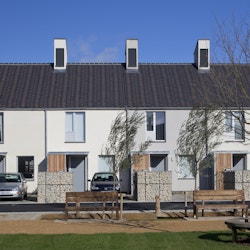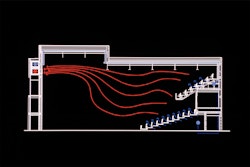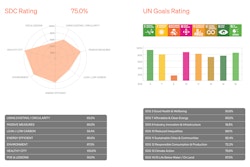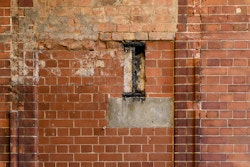Sustainability
We design responsible and intelligent buildings and places. Guided by our LEAN approach, we aim to create positive change with minimal impact by building passively, intelligently, and with and for nature.
The Green Urbanist – Will, Jack and Sophia give an insight into our studio's culture and processes for delivering sustainable projects. Listen here

Every design decision has a carbon impact
At Howells, we recognise the built environment’s impact on biodiversity, pollution, and climate change. As architects and designers, we have agency in addressing this impact by reducing our designs’ carbon footprint significantly to ensure we adhere to the science-based targets set by the Paris Agreement.
We need to measure the emissions generated by our design, not only in terms of energy but also embodied carbon—the emissions associated with extracting resources and making building components. Our design choices must minimise these regardless of scale or function. To do otherwise would be reckless.

From our first projects, we have sought to integrate low-energy environmental control systems into our buildings. The Market Place and The Courtyard employ the Termodek system to maintain temperature without expensive and energy-consuming chillers by passing air through the masonry structure.
How do we make better choices?
We have developed a toolkit around design principles that helps us appraise our buildings’ environmental impact whilst ensuring nature and existing or new ecosystems remain integral to our design solutions. These principles—when applied together—are commonly called ‘Low Carbon Design.’
Our in-house ‘Low Carbon Design Toolkit’ allows us to interrogate site-specific design options relating to embodied and operational carbon. It records each project’s ambitions and achievements related to sustainable and regenerative parameters.
Where relevant, our Toolkit is used at key project milestones for testing targets and reviewing design decisions. It also allows us to evaluate improvement across our projects and benchmark their embodied carbon footprint against industry-standard targets. The tool is still evolving to reflect current options for circular principles and regenerative design.

Our in-house sustainability rating system
How do we get to regenerative design?
Regenerative design requires a new perspective; one that values nature and the use of existing resources through ‘urban mining’. It also aims to restore ecological systems and biodiversity by adopting a design approach that works with, not against, nature.
This approach implies focusing more on retrofitting existing structures and using upcycled and/or bio-based materials and building systems or components wherever possible. For new buildings, this means exploring alternatives to new materials by reusing existing resources—thus reducing new extraction of raw materials—which will need little (re)processing to get a new lease of life and purpose.
When new materials are required, priority should be given to low carbon options, e.g. biobased materials and materials produced locally or regionally, and based on processes that design out carbon emissions and waste. Innovative materials that mimic nature’s inherently efficient biological systems are part of regenerative design too, which can only be supported by an outstanding design team collaboration.

There are real environmental benefits in reusing buildings and structures. Working in Birmingham, we revitalised the historic Assay Office building into a modern workplace.
It’s not just our projects
Our business commitment reflects our sustainability and regenerative approach to design but also our values as an employer. We measure our emissions to evaluate our carbon impact and have started our journey to decarbonisation wherever possible. In early 2023, we commissioned consultants Eight Versa, to measure our Scope 3 emissions and build a robust picture of our carbon footprint. Following the measurement, we are activating a clear reduction plan, setting targets to meet the UK target of Net Zero by 2035.
Howells are signatories of Architects’ Declare 11 Points, committed to the RIBA 2030 Climate Challenge and the UN Race to Net Zero through the SME Climate Hub.
We are proud to support the Architects Climate Action Network, LETI, Good Homes Alliance and the UK Net Zero Carbon Building Standard.

Each of our studios promotes active travel with cycle storage and showers readily available in both.